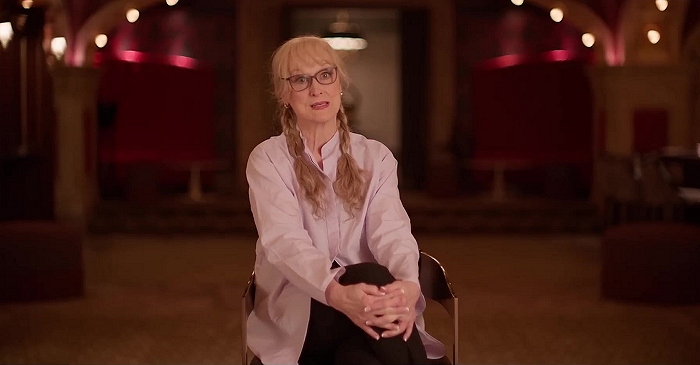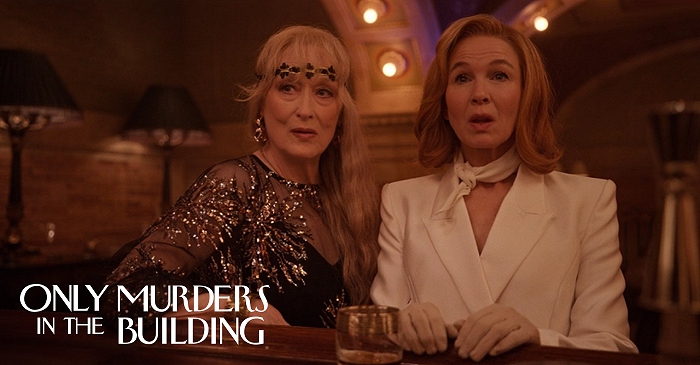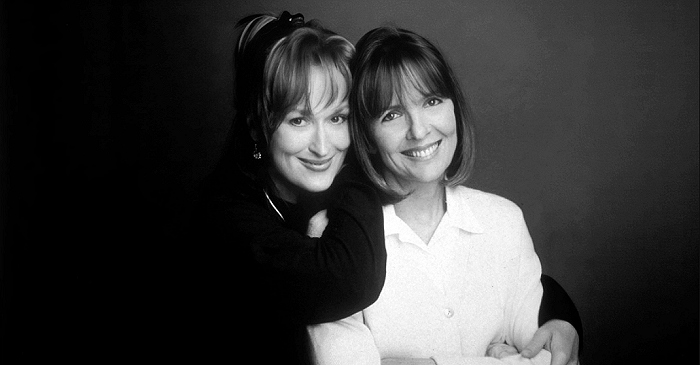|
Simply Streep is your premiere online resource on Meryl Streep's work on film, television and in the theatre - a career that has won her acclaim to be one of the world's greatest living actresses. Created in 1999, Simply Streep has built an extensive collection over the past 25 years to discover Miss Streep's body of work through thousands of photographs, articles and video clips. Enjoy your stay and check back soon.
|
|
The Karen Silkwood File
The Observer ·
April 08, 1984
| ||
|
Tags
|

On the evening of 13 November 1974 Karen Silkwood, a 28-year-old laboratory assistant, left a union meeting near her work in an Oklahoma plutonium plant to make a 30-mile drive to Oklahoma City. She was a skilled driver, travelling alone on an important mission – to deliver to an official from her union’s national headquarters documented evidence of radiation leaks and other hazardous – practices in her workplace: a plutonium recycling plant operated by the Kerr-McGee Corporation. She had gathered the evidence secretly, but in an amateurish way which aroused the suspicion of her employers, and she was last seen minutes before she started on her journey, carrying a manila folder. Karen never reached her destination. Unaccountably, her car veered off the lonely road and plunged into a deep culvert. She was killed instantly and the manila folder was never found. Police ruled her death accidental, but experts from her union who examined her battered car alleged that some of its damage was consistent with it having been rammed from behind by a heavier vehicle. A post-mortem showed that Karen had low levels of alcohol and a tranquilising drug in her body, suggesting another possible cause of death. Was she murdered or did she fall asleep at the wheel? And what happened to the documents which she was expected to hand over to the two men who were waiting for her in an Oklahoma City hotel – the union official and a New York Times reporter? Did someone remove the folder from the car after the accident? Or did she make a last-minute decision not to take it with her? And, if so, why hasn’t it shown up somewhere else? For almost a decade America’s anti-nuclear activists have debated these questions. Many of them have come to regard Karen Silkwood as something of a martyr, and the mystery of her fatal car crash has generated almost as much speculation as the assassination of President Kennedy. In death she has become larger than life: a symbol of all the courageous common people who dare to pit themselves against the giants of industry or government without regard for personal consequences. Her name is often cited by feminists, by peace marchers, and by the kind of women who shiver in the mud of Greenham Common trying to convince themselves it is all worthwhile.
Those of us who followed her story from the beginning felt sure that one day Hollywood would make a film of it, with Jane Fonda in the title role. Indeed, this almost happened. With the cinema in mind, two graduate students of the University of California Film School, Buzz Hirsch and Larry Cano, spent seven years compiling news reports, transcripts of hearings and taped interviews with Karen Silkwood’s friends, relatives and colleagues. Jane Fonda bought the film rights to all this material but later released them, after ‘The China Syndrome’. Meryl Streep’s agent stepped in. The result of all this is the film ‘Silkwood’, opening in London this week and already highly acclaimed (and a source of considerable controversy) in the United States, with a stunning performance by Meryl Streep as Karen. The script (a first venture into film work by American journalist Nora Ephron and author Alice Arlen) closely follows the carefully researched story. Streep’s Silkwood is not what Fonda’s might have been – a high-minded activist but a flesh and blood creature who is a bit of a slut, blowing bobble gum on the job, wearing clothes a trifle tarty, trying out her charms on the foreman when she wants a weekend off; in short a personality which comes very near to what is known of the real Karen Silkwood. A couple of earlier biographers who, independently, have produced books on Karen Silkwood seemed to have difficulty with this reality. They glossed over a point which the film’s scriptwriters were not afraid to make – that after producing three children by a man she never married, Karen broke up the relationship, left him in charge of their offspring in Texas and moved to Oklahoma where she lived on and off with a married man. Otherwise she shared a flat with a girlfriend, impressively played by the American television and cabaret star Cher.
Cher’s role is a composite of two real-life girlfriends of Karen’s, one of whom reacted so violently to the news of her car crash that she ran to the Kerr-McGee plant brandishing a shotgun. ‘If that scene had been put into the movie, people would have said it was a Hollywood exaggeration, but it really happened,’ Meryl recalled in an interview. She said, and clearly meant it, that she loved playing the part of Karen, and although she spoke of their similarities one is also struck by their differences. For the interview in a Manhattan hotel suite she was wearing a billowy dark dress, wine merging into black, against which her clear fair skin looked positively translucent. She spoke softly, and with consideration for her visitor. (‘Do you mind if I smoke? I only like a cigarette occasionally. Having to do all that chain-smoking in the film wasn’t at all pleasant.’) A thought which kept crossing my mind as we talked was how the differences of birth and education can show so clearly in the looks of a person. The real Meryl Streep is immensely ladylike; Karen Silkwood was working class through and through. The skill of Meryl’s film performance is that she is able to make the transition, to coarsen her behaviour, even her looks, to such an extent that there is only a passing physical resemblance between her real self and her portrayal of Karen Silkwood. She did feel a great empathy with Karen. ‘I’ve done more literary types in the past, but Karen Silkwood is closer to what I’m really like than, say, The French Lieutenant’s Woman. I’m from a small town like she was, and I, too, went to an American high school and worked for a living. Like her, I operate on my gut feelings, my emotions, not always analysing from a distance. ‘That helps me to understand the motives for her actions. I don’t think they were always completely, pure. She was one of those people who chafed against authority; hers was the kind of personality which likes to cause trouble. Some part of her was genuinely disturbed by the sloppy conditions at the plant, and the dangers to workers, and some part of her was attracted by the headiness of the adventure. It reminded me of my own bit of political action in my college days when we were demonstrating against the Vietnam war, against the involvement of industry in scientific research; while we cared about these things it was also glamorous and exciting to be part of those demonstrations.
‘The great irony with Karen Silkwood is that she was the kind of person whom anti-nuclear groups would have disliked. She worked in a nuclear plant. She was keen on nuclear energy. It was only the working conditions she minded.’ This matter-of-fact approach makes Meryl Streep’s Silkwood very believable. The film deals with the two years of Karen’s employment at the Kerr-McGee plant, beginning with her treating it as casually as any tedious job at a factory bench and moving to her concern about the materials which she and her colleagues were handling after she saw a woman worker who had been exposed to plutonium being dragged, screaming, to the decontamination showers. Subsequently Karen also had to be decontaminated, and there is a shocking scene in the film where she is held under the shower by a strong nurse while jets of water are forced up her nostrils. ‘They filmed that sequence twice and wanted to do it another time, but I said no.’ This exposure was the start of Karen Silkwood’s union activism, and it was not welcomed by Kerr-McGee. Encouraged by national leaders of her union, she spoke out at local meetings about the cancer risk of working with plutonium. Surprisingly, this was news to many of her colleagues. She also took surreptitious photographs of allegedly faulty equipment and helped herself to company files in an attempt to establish her claim that Kerr-McGee was making defective fuel rods.
The film deals quite fully with one of the most troubling incidents in the Silkwood story, only days before her death. Checking into work one morning Karen registered high radiation levels, whereupon Kerr-McGee dispatched a decontamination squad to her home. Detectable levels of plutonium were found in the bathroom and kitchen, even contaminating food in the refrigerator, and while Karen watched helplessly the place was stripped of its furnishings, wallpaper, even photographs of her children. Four and a half years later her family sued Kerr-McGee for negligence in permitting the contamination and, in a landmark court decision, $10.5 million damages were awarded to her estate (money which is still tied up by a series of appeals). Evidence at the federal trial substantiated Karen Silkwood’s charges about sloppy procedures at the plant, including needless exposure of workers to radiation, and about quantities of plutonium simply ‘lost’. A former supervisor testified that he ‘never saw anything so filthy’ in his life: ‘The place was a pig-pen.’ By that time Kerr-McGee had closed down this notorious plant for good.
At the trial some Kerr-McGee officials alleged that Karen Silkwood stole small quantities of plutonium from her workplace in order to spike her own urine samples which, at this point, she was required to take into the firm’s medical department for daily checking. They charged that she had ‘both the motive and intent’ to do this, and that she was trying to create a case against the company by making her own contamination levels appear higher than they really were. They alleged that she was rather clumsy about it and thus tracked plutonium residue around her home. This suggestion was rejected by the jury. The Silkwood lawyers convinced the jury that Karen would never have taken such a risk. She was already terrified of developing cancer (curious, in the light of her incessant chain-smoking). Whatever the true cause of the contamination, she was effectively removed from the scene of important contract negotiations between the company and its staff. (Kerr-McGee sent her to hospital for a week of tests.) As to the fatal accident Streep says, ‘I don’t know what happened. I went into the movie thinking that of course she was killed, but now it’s more of a mystery to me than ever. ‘During the filming I became worried that something might happen to me too. I wrote a little note to my husband saying, “Hi, darling. If I die you’ll know who did it.” Afterwards I realised that was absurd. We were not presenting anything in the film which was not a matter of public record. We did not need to embellish the story. It’s all there.’
Meryl learnt a lot about Karen Silkwood’s mannerism and quirks of character from her steady boyfriend, Drew Stephens (played in the film by Kurt Russell). She found him running an automobile repair shop in Oklahoma City and spent two days talking to him about Karen. ‘He was quite forthcoming. Afterwards when he saw the film he said it really made him feel better. For several years after she died he was troubled by the thought that he could have prevented her from setting out that night. He hadn’t wanted her to become so involved. The film was cathartic for him because it helped him to understand that she was on that course inexorably. It assuaged his feeling of guilt.’ Even now that she is beginning work on another film, Meryl Streep remains fascinated by the character of Karen Silkwood. ‘She was full of contradictions. She loved her children and yet she left them. That bothered me and I made up reasons for myself to explain why she did it, and I can sort of see why. Emotionally she was quite unstable. She was on to Kerr-McGee about safety, yet sometimes she smoked dope and popped pills on the job. ‘The extent of her involvement in the nuclear issue was unusual. It’s true what they say about women: they have more endurance. They don’t always go the easiest way about things like this, but in the long run they are effective. A lot of people get involved at ground level. But it’s going to the utmost limit at whatever cost that’s so rare.’


Posted on October 18th, 2025
|
Posted on October 14th, 2025
|
Posted on October 11th, 2025
|
Posted on September 30th, 2025
|
Posted on September 16th, 2025
|














